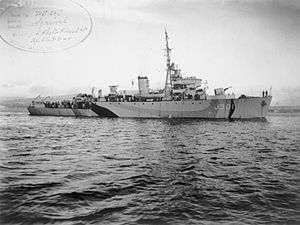HMS Squirrel (J301)
HMS Squirrel was a turbine-powered Algerine-class minesweeper built for the Royal Navy during the Second World War. She was scuttled after striking a mine in 1945.
 HMS Squirrel underway in Belfast Lough on completion. | |
| History | |
|---|---|
| Name: | HMS Squirrel |
| Ordered: | 30 April 1942 |
| Builder: | Harland and Wolff, Belfast[1] |
| Yard number: | 1206[2] |
| Laid down: | 20 August 1943 |
| Launched: | 20 April 1944 |
| Completed: | 16 August 1944[2] |
| Commissioned: | 16 August 1944 |
| Fate: | Hit a mine and subsequently scuttled, 24 July 1945[3] |
| General characteristics | |
| Class and type: | Algerine-class minesweeper |
| Displacement: |
|
| Length: | 225 ft (69 m) o/a |
| Beam: | 35 ft 6 in (10.82 m) |
| Draught: | 11 ft (3.4 m) |
| Installed power: |
|
| Propulsion: |
|
| Speed: | 16.5 knots (30.6 km/h; 19.0 mph) |
| Range: | 5,000 nmi (9,300 km; 5,800 mi) at 10 knots (19 km/h; 12 mph) |
| Complement: | 85 |
| Armament: |
|
Design and description
The turbine-powered ships displaced 850 long tons (860 t) at standard load and 1,125 long tons (1,143 t) at deep load. The ship measured 225 feet (68.6 m) long overall with a beam of 35 feet 6 inches (10.8 m). The turbine group had a draught of 11 feet (3.4 m). The ships' complement consisted of 85 officers and ratings.[4]
The ships had two Parsons geared steam turbines, each driving one shaft, using steam provided by two Admiralty three-drum boilers. The engines produced a total of 2,000 shaft horsepower (1,500 kW) and gave a maximum speed of 16.5 knots (30.6 km/h; 19.0 mph). The ships carried a maximum of 660 long tons (671 t) of fuel oil that gave them a range of 5,000 nautical miles (9,300 km; 5,800 mi) at 10 knots (19 km/h; 12 mph).[4]
The Algerine class was armed with a QF 4 in (102 mm) Mk V anti-aircraft gun[5] and four twin-gun mounts for Oerlikon 20 mm cannon. The latter guns were in short supply when the first ships were being completed and they often got a proportion of single mounts. By 1944, single-barrel Bofors 40 mm mounts began replacing the twin 20 mm mounts on a one for one basis. All of the ships were fitted for four throwers and two rails for depth charges.[4]
Construction and career
She was launched in 1944. Squirrel took part in minesweeping operations off the west coast of the Malay peninsula on 24 July 1945.[6] The operations were supported by the British East Indies Fleet, which defeated a Japanese kamikaze attack on HMS Ameer at the time.[6] Squirrel hit a mine off Phuket Island during the attack, and was scuttled by Royal Naval gunfire two and a half hours later.[3] Seven men were lost in the attack.[3]
References
- "NMM, vessel ID 376280" (PDF). Warship Histories, vol x. National Maritime Museum. Archived from the original (PDF) on 2 August 2011. Retrieved 1 August 2011.
- McCluskie, Tom (2013). The Rise and Fall of Harland and Wolff. Stroud: The History Press. p. 153. ISBN 9780752488615.
- Brown, David (1995). Warship Losses of World War Two. London: Arms and Armour. p. 155. ISBN 1854092782.
- Lenton, p. 261
- Chesneau, p. 65
- "Suicide Plane Attack Fails". The Southeast Missourian. Associated Press. 30 July 1945. p. 1. Retrieved 1 August 2011.
Bibliography
- Chesneau, Roger, ed. (1980). Conway's All the World's Fighting Ships 1922–1946. Greenwich, UK: Conway Maritime Press. ISBN 0-85177-146-7.
- Colledge, J. J.; Warlow, Ben (2006) [1969]. Ships of the Royal Navy: The Complete Record of all Fighting Ships of the Royal Navy (Rev. ed.). London: Chatham Publishing. ISBN 978-1-86176-281-8.
- Lenton, H. T. (1998). British & Empire Warships of the Second World War. Annapolis, Maryland: Naval Institute Press. ISBN 1-55750-048-7.
This article includes data released under a Creative Commons Attribution-ShareAlike 3.0 Unported UK: England & Wales Licence, by the National Maritime Museum, as part of the Warship Histories project.